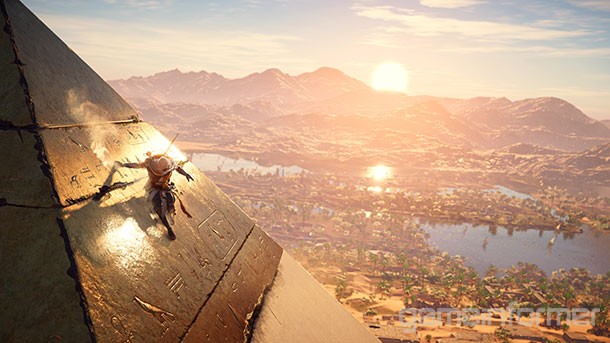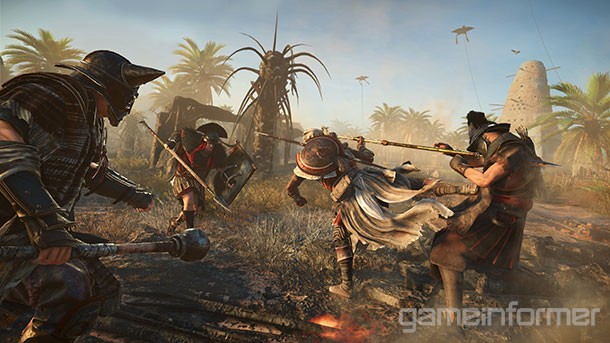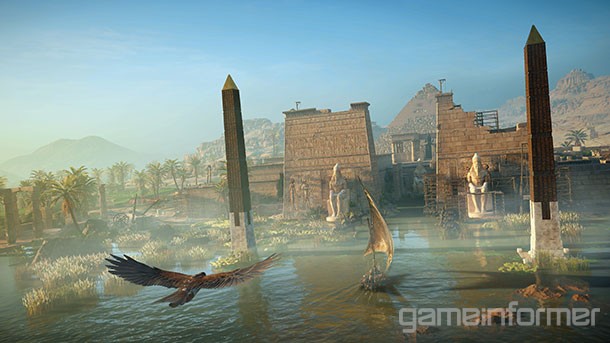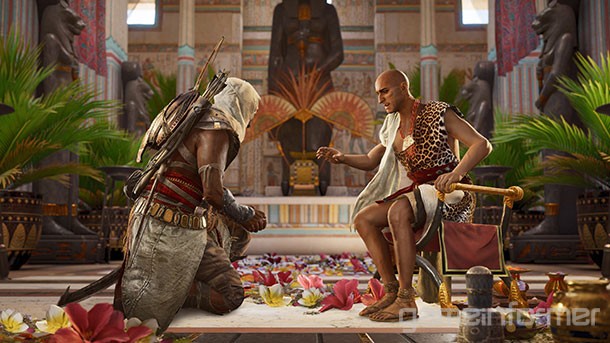Five Things You Need To Know About Assassin’s Creed Origins

After a year off, Assassin's Creed is back, and this time it's taking us to ancient Egypt to see how the brotherhood was formed. Ubisoft took the stage at Microsoft's press conference to unveil Assassin's Creed Origins, providing your first substantial look at the game. Did you want more? Fortunately, it's also our July cover story. We visited Ubisoft's studio in Montreal to get the first big details and go hands-on with the game. Here are five things you should know about the newest entry in Ubisoft's juggernaut franchise.

You Play As Bayek, The Last Medjay
Every Assassin has his or her own unique journey. In Origins, you assume the role of Bayek, an Egyptian who is the last Medjay. The role of a Medjay in the old kingdom is similar to a local sheriff - their role is to protect the community, making Bayek a well-known and respected man. What sets Bayek on his journey is a mystery you'll uncover while playing the game. He's not an assassin out of the gate, but he's building toward it. He's also a bit more mature than our previous protagonists. "We wanted to be accessible to a younger audience, but the story we wanted to tell was the story of a man in his 30s - almost mid-life for the time - and having to make some huge choices to change his life in order to change the world," says creative director Jean Guesdon.
From our hands-on time, it was clear Bayek is a determined man, with a more stoic personality than previous assassins. That doesn't mean he's emotionless, though. Bayek has an intensity about him. "When he's angry, he's angry," Guesdon says. "When he's enjoying the good life with friends, he will be laughing with the same intensity. He's really here for other people, basically."

Egypt Has A Lot More To It Than Pyramids
Origins invites you to explore a vast landscape. "It's a huge world. Basically, we took the size of Black Flag's Caribbean, but on the ground, so a lot of locations to travel that will allow us to show how rich ancient Egypt was," Guesdon says. When we think of Egypt, pyramids, deserts, and oases often come to mind, but you'd be mistaken to think that's all Origins offers. You have locales like the Nile Delta, a flatter landscape that's very lush and green with crocodiles hiding in the swamps. The region includes Alexandria, with its Greek/Roman influence and density of architecture. "When you're in Alexandria you have this opulent, massive architecture for Cleopatra's palace and the lighthouse," says art director Raphael Lacoste. The ancient city of Memphis, at the mouth, is more representative of the Old Kingdom, featuring more minimalistic architecture with temples and mud-brick houses. Even the deserts have a lot of variation to them. "We have sand dunes, but you also have the white desert with amazing shapes of salty rocks, it looks almost like an alien landscape," Lacoste says.
These areas are also teeming with wildlife. During our demo, we saw everything from hippos to camels roaming the landscape. "In the Nile Delta, we have all the diversity of birds; we need to have the iconic ibis," Lacoste says. "When you go into the desert maybe you see the hyenas and the lions, we created this contrast of experience that you can encounter with the animals."
The game also has 20 tombs and ruins to explore. Some are based on real locales, while others the team put their own creative twist on. "It was an interesting challenge, because we're not Tomb Raider, and we didn't want to go in that direction of being too puzzly," Guesdon says. The tombs have some light puzzles in them, but are more about exploration. Expect a few traps littered about, but the bulk of the experience is finding your way around and stumbling upon secrets and treasures. The team created tombs to offer some contrast from the vast, open world. "When you open a tomb or a secret location, you feel the difference," Guesdon says. "You immediately sense that it's not the same world; you have echoes, it's dark, you need to bring out your torch and you look around and you really feel this vibe of its exploration, it's Indiana Jones almost."

The Controls Have Changed
Ubisoft wanted to reinvent Assassin's Creed with Origins, and part of that shift was revamping the controls. Combat now revolves around the right shoulder and trigger; the shoulder lets you execute your light attack, while your trigger is your heavy strike. Your dodge and parry buttons are on the face buttons, while the left shoulder button lets you lock onto enemies. The run button is also gone. Now your character automatically moves at top speed when the analog stick is held in any direction. "We wanted something more seamless across the board, whether you're on a felucca [a small boat] or a horse or on ground, the controls are the same," says game director Ashraf Ismail. "The idea is that the controls are more accessible for players. To do that, it actually forced us to really reconsider what it means to fight in this context in this world on these vehicles on the ground and so on."
Combat feels much more deliberate and calculated than past entries. Positioning matters, as enemies attack from all sides and all at once. The team improved the A.I., so NPCs no longer wait for their ally to finish their attack before coming at you, making battles deadlier than ever. Not locking onto an enemy could mean attacking the air, and blocking with Bayek's shield is a must. "In previous ACs, when you press attack you were really locked into an animation and there was no concept of hitting or missing open air," Ismail explains. "Here, there's that concept. You can swing your weapon and if there's no one there, you're open and they can come in. You have to pay attention to your positioning and your enemies and what weapons they have. The fight system asks for a lot more skill."
The control change was the hardest shift for us to get used to in our demo. It takes time to retrain your brain, and we had our share of times where we hit the new dodge button to attack. If for some reason, you can't get used to these controls, the game will have other options. "In the final game there will be multiple controller layouts and players will be able to customize the controls, because what we've seen is that with our new controller layout some people fall in love with it and other people want legacy stuff, so we give the option too," Ismail says.
Click to the next page to find out about your eagle companion and the game's RPG direction...

You Control Your Eagle
Eagles have long been associated with the Assassin's Creed series, but Origins is taking this relationship to a new level by giving you an eagle companion named Senu. With Senu, you can get an aerial view of the landscape, helping you locate treasure chests, mark enemies, and discover hidden passages. Yes, Eagle Vision is now very literal. Pressing up on the d-pad, allows you to take control of Senu, changing your perspective. You can ascend and descend to zoom in on different areas.
During our hands-on demo, this was one of the more promising new features. Infiltrating camps is no longer guesswork; you can mark enemies, get the lay of the land, and map out your strategy ahead of time. This is also extremely beneficial for loot hunters, as Senu can alert you to all types of treasure, even if it's tucked away under water. "The eagle has always been a very important symbol, and we wanted it to have weight in the game," Ismail says. "Not just visually, not just through symbols, but also in the gameplay. For us, it was a very natural extension to have this creature and make it a companion to Bayek."

The Series Takes A More RPG Tack
When we sat down with the developers one of the first things they expressed is Origins taking the series in a more RPG-like direction. "This is moving from a pure action-adventure to an action-adventure-RPG, because we feel that's what players want nowadays," Guesdon says. "They want to be in charge of their adventure and switch from one story to the next."
What does this mean for the franchise exactly? First off, Origins moves away from a mission structure to quests, and all quests have a suggested level on them. Don't expect to take on quests a few levels ahead of you with ease either. During our demo, we learned this firsthand when we walked into a quest three levels ahead of us and got annihilated. A higher level enemy getting just a few hits on you can be deadly.
Equipment is also of the utmost importance, something that you must upgrade to the appropriate level to survive. This doesn't just mean your armor, but also your weapons, even your hidden blades. Unlike previous entries, until you level up your hidden blades, you won't be able to instant kill enemies that are at higher levels than you. "You have to play with the RPG elements of the game, you have to level yourself up," Ismail says. "Questing is one of the great ways to level up, but there are other ways to level up of course. We've given many avenues for how the player gains XP, how the player gains crafting material, how the player gains equipment and gear, and it's all quite well-integrated into the questing system."
Leveling your character up gives you points to invest in new abilities. Origins uses a graph system inspired by Final Fantasy X's sphere grid. "Instead of having a straight tree, in which players had to invest skill points along a fairly regimented path, the graph's structure provides multiple routes to skills, allowing for more flexibility," Ismail says. The graph is broken up into three main disciplines. The Warrior path allows you improve your combat prowess, letting you unlock new combos and moves to withstand battle. The Hunter portion centers on stealth (the standard Assassin powers), improving your bow skills and ability to stay undetected. The Seer section focuses on using the world around you to your advantage, granting you abilities to tame animals or poison enemies. The graph houses a wide variety of abilities. We saw everything from being able to auto-loot corpses to air attacks to using eagle Senu to stun enemies.
For more on Assassin's Creed Origins, check out our in-depth hands-on impressions to learn more about how all these new elements come together.

Get the Game Informer Print Edition!
Explore your favorite games in premium print format, delivered to your door.
- 10 issues per year
- Only $4.80 per issue
- Full digital magazine archive access
- Since 1991










